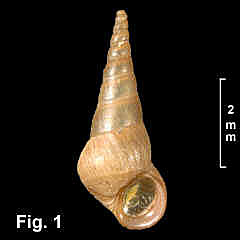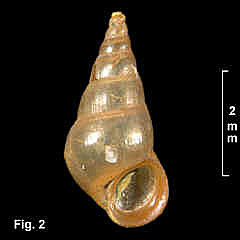|
|
HYDROBIIDAE |
|
|
|
Tatea rufilabris (Adams, 1854) Description: Shell small, variable in length to width ratio (1.91 - 2.71), spire straight to concave in outline. Protoconch of 2 whorls, last whorl without spiral threads; junction with teleoconch well defined. Teleoconch of up to 7 weakly rounded whorls, smooth except for growth lines. Last whorl rounded or angled at periphery; sometimes with weak spiral rib starting at top of aperture. Aperture oval, with thickened peristome, this sometimes red or orange; outer lip with sharp edge, inner lip thickened. Umbilicus a very small chink. Shell translucent white when fresh, becoming opaque with age, covered with thick dark brown periostracum. Size: Up to 5 mm in length. Distribution: Endemic to Australia: Caloundra, Qld, southwards and around southern Australia to Perth, WA. Habitat: Restricted to lagoons and estuaries, in the upper part of the shore, in the same habitat as T. huonensis. Comparison: Ponder et al (1991) said that "this species can be separated from T. huonenis by its narrower shell, smooth protoconch II, concave spire and peripheral fold [rib]". NSW specimens of this species are usually elongate with concave spire (Fig. 1) and are readily identified, but elsewhere in the range the characters overlap between this species and T. huonenis, or are absent , making the two species difficult to separate on shell characters
Remarks: The anatomy, radula and distribution of this species is described by Ponder, Colgan & Clark (1991). Fig. 1: Bristol Point, Jervis Bay, NSW (C.314512) Fig. 2: Pats River, Flinders Island, Bass Strait (C.307364) |
|

